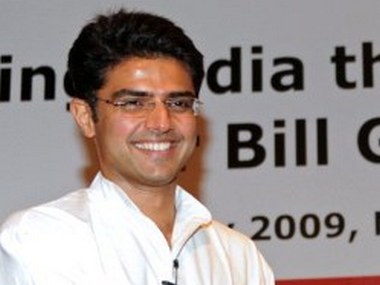In the 2009 Lok Sabha election the Congress won 20 out of the 25 seats in Rajasthan. How many would its leaders be happy winning this time? Talk to any party leader, speak to its staunchest supporter, poke its die-hard fan, the answer is the same: everybody is afraid of a BJP clean sweep in Rajasthan. The Congess leaders would not be surprised if their party loses all 25, they would be relieved if it wins 1-2 seats. If the tally reaches 5, the Congress would feel it has pulled off a miracle. [caption id=“attachment_143565” align=“alignleft” width=“380”]  The Congress’s new boss in Rajasthan may shift from Ajmer to Tonk[/caption] History is loaded heavily against the Congress. In the recent Vidhan Sabha election, the gap between the BJP and the Congress was nearly 13 per cent. Traditionally, the gap between the winner and the loser of the Vidhan Sabha polls goes up by another 7-8 per cent in the Lok Sabha elections. If the trend continues, the BJP and the Congress might be separated by 20 per cent votes in the Lok Sabha. In a bi-polar state like Rajasthan, 20 per cent is a huge gap. To put it in perspective, in 2009, this difference was around 10 per cent. And the final tally: Congress 20, BJP 4, others 1. Those who understand the poll trend in Rajasthan and its history of one-sided results (for instance, 25-0 for the Congress in 1984, 0-25 in the next) know that the Congress could draw a blank. Their fears are betrayed by the caution and confusion in the party. Most of its leaders are hunting for safe seats and its high-command can’t decide what to do with the incumbent MPs. As a result, the list of candidates is stuck even after several rounds of discussion. Consider the plight of its top leaders. During the recent Vidhan Sabha election, the party’s on–field commanders were the then chief minister Ashok Gehlot and the state unit chief Chandrabhan. The triumvirate was completed by Union minister CP Joshi. Since December 8, when the results were declared, Chandrabhan has vanished. Nobody has heard of him since Chandrabhan lost his deposit and came in fourth in a quadrangular contest. Since this was his third defeat in as many elections, it is suspected that Chandrabhan has finally retired from electoral politics. Joshi is also contemplating retirement. Joshi has repeatedly conveyed his desire to work only for the party. But the Congress wants him to contest the next poll from Jaipur (rural), primarily because the party has run out of recognizable faces for the 25 seats in Rajasthan. Unlike his colleagues who have stepped aside gracefully, Gehlot is still thrashing around in the bog of the 2013 defeat. But the party seems in no mood to rescue him from disappearing. Gehlot has put forth his son’s name as a Lok Sabha candidate, but so far the party has shown no signs of obliging him. The party’s new boss in Rajasthan, Sachin Pilot, is also worried about his electoral prospects. Pilot is reportedly keen to shift to Tonk-Sawai Madhopur from his current Ajmer constituency. Defeat in Ajmer is a certainty; in Tonk he still has a chance. The party’s resistance would be limited to a few individuals whose appeal transcends party barriers. One of them is Rajbala Ola, daughter-in-law of Jat heavyweight Sis Ram, who died recently. A sympathy wave could combine with the Jat vote here to help Ola’s retain the Jhunjhunu constituency. The party’s chances look good in Karauli as well. This is the only Lok Sabha constituency in which the Congress had polled more votes than the BJP in the Assembly election. If voters don’t change their mind, the Congress may be able to pocket this seat. In a way, two out of 25 would be a fair result since the Congress had won just 10 per cent seats in the Assembly elections. Anything better would be seen as a huge gain. With the vote share slated to dip and its leadership in the grip of panic, the Congress cadres have realised that their party’s chances are dismal. The interest now is focused on how bad the defeat would be and how the party would get back on its feet after the mauling. The biggest fear in the Congress is that a 20 per cent gap in Lok Sabha polls would perhaps be the highest in the country between the two parties. And it is a gap that could decades to fill.
Chandrabhan has vanished after three defeats, CP Joshi wants to do party work, others hunting for safe seats. As a result, the list of candidates is stuck even after several rounds of discussion.
Advertisement
End of Article


)
)
)
)
)
)
)
)
)



